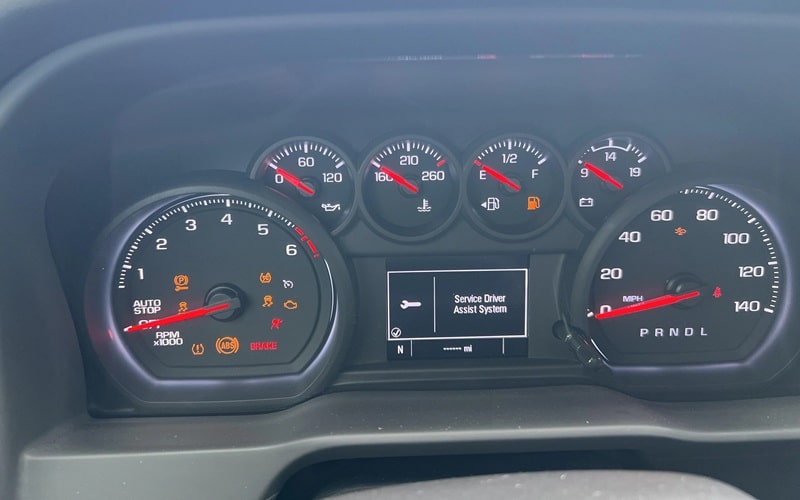2023 Chevy Trailblazer Tire Pressure Monitor System
The Chevy Trailblazer has an advanced tire pressure monitoring system (TPMS) designed to enhance safety, improve fuel efficiency, and extend tire life. This intelligent system continuously monitors the air pressure in all four tires and alerts the driver when any tire falls below the recommended inflation level. Understanding how this system works and how to […]
The Chevy Trailblazer has an advanced tire pressure monitoring system (TPMS) designed to enhance safety, improve fuel efficiency, and extend tire life. This intelligent system continuously monitors the air pressure in all four tires and alerts the driver when any tire falls below the recommended inflation level. Understanding how this system works and how to respond to its warnings is essential for maintaining your vehicle in optimal condition.

How the Tire Pressure Monitor System Functions
The Trailblazer uses a direct TPMS, which means each wheel contains a dedicated sensor mounted inside the tire on the valve stem. These battery-powered sensors measure the air pressure and temperature inside each tire, transmitting this data wirelessly to the vehicle’s onboard computer.
The system displays real-time tire pressure readings for all four tires on the driver information center, accessible through the steering wheel controls. When the pressure in any tire drops approximately 25% below the recommended level (typically around 35 kPa or 5 psi), the system triggers a warning.
This warning appears as an illuminated TPMS symbol on the dashboard—a yellow icon resembling a tire cross-section with an exclamation mark. In more severe cases, the system may display a “Low Tire Pressure” message along with information about which specific tire requires attention.
Benefits of the Trailblazer TPMS
The tire pressure monitoring system in the Trailblazer offers several important advantages beyond mere convenience:
Enhanced Safety: Properly inflated tires provide better traction, handling, and braking performance. The TPMS helps prevent accidents caused by underinflated tires, which can lead to reduced vehicle control, particularly during emergency maneuvers or adverse weather conditions.
Improved Fuel Economy: Underinflated tires increase rolling resistance, forcing the engine to work harder and consume more fuel. Studies show that maintaining proper tire pressure can improve fuel efficiency by up to 3%, translating to significant savings over time.
Extended Tire Life: Tires that run consistently underinflated wear prematurely and unevenly. The TPMS helps ensure even tread wear, potentially extending tire life by thousands of kilometres.
Reduced Environmental Impact: Better fuel efficiency means reduced carbon emissions, while extended tire life means fewer tires ending up in landfills—both contributing to environmental sustainability.
How to Access Tire Pressure Information
The Trailblazer makes it easy to check tire pressure readings through the driver information center. To access this information:
- Use the steering wheel controls to navigate through the available display options
- Select the “Vehicle Information” menu
- Choose “Tire Pressure” from the submenu
- View the pressure readings for all four tires displayed in kilopascals (kPa)
The system displays the current pressure for each tire in a clear diagram showing the vehicle layout, making it easy to identify which tire corresponds to which reading. This interface also indicates the recommended pressure setting, typically around 241 kPa (35 psi) for the Trailblazer, though this may vary based on load conditions.
TPMS Warnings and What They Mean
The Trailblazer tire pressure monitoring system uses different alerts to communicate various issues:
Steady TPMS Warning Light: This indicates that one or more tires are significantly underinflated and require immediate attention. The driver information center will display which tires are affected and their current pressure readings.
Flashing TPMS Warning Light: If the warning light flashes for approximately one minute when starting the vehicle and then remains illuminated, this indicates a potential system malfunction. This could be due to sensor battery failure, signal interference, or a system component issue.
“Service Tire Pressure System” Message: This indicates a communication failure between the sensors and the vehicle’s computer. This could be caused by sensor malfunction, dead sensor batteries, or electronic interference.
How to Respond to TPMS Alerts
When the TPMS warning light illuminates, follow these steps:
- Find a safe location to stop and check your tires visually for damage or obvious low pressure
- Use a quality tire pressure gauge to check all four tires
- Add air as needed to reach the recommended pressure listed on the driver’s side door jamb sticker
- If a tire continually loses pressure, have it inspected for punctures or valve stem leaks
- After inflating the tires, drive for a short distance to allow the system to update its readings
If the TPMS light remains on after properly inflating all tires, or if it flashes before staying illuminated, the system may require a reset or professional diagnosis.
How to Reset the TPMS
The Trailblazer includes a TPMS reset function accessible through the vehicle’s information display. This reset is necessary after tire rotation, tire replacement, or sensor replacement. To reset the system:
- Navigate to the “Vehicle Information” menu using the steering wheel controls
- Select “Tire Pressure”
- Look for and select the “TPMS Sensor Matching” or “Relearn” option
- Follow the on-screen instructions, which typically involve putting the vehicle in service mode and using a TPMS relearn tool to activate each sensor in sequence
For more complex resets, particularly after installing new sensors, the process may require dealer assistance or a compatible TPMS programming tool.
TPMS and Seasonal Tire Changes
For regions with distinct winter and summer seasons, many Trailblazer owners switch between all-season and winter tires. This presents unique considerations for the TPMS:
Separate Sensor Sets: Ideally, both tire sets should have their own TPMS sensors, allowing for easier seasonal changes without reprogramming.
Relearn Procedure: When switching between tire sets with sensors, the system needs to relearn the sensor positions. This ensures the pressure readings correspond to the correct wheel positions.
Temperature Considerations: Air pressure decreases by approximately 7 kPa (1 psi) for every 10°C drop in temperature. During seasonal transitions, the first major temperature drop may trigger the TPMS warning, even if you properly inflated the tires in warmer weather.
System Maintenance and Sensor Lifespan
The TPMS sensors in the Trailblazer are durable and long-lasting, but they do have certain limitations:
Battery Life: The sensors contain non-replaceable batteries with an expected lifespan of 5-10 years. When a battery fails, you must replace the entire sensor module.
Physical Damage: Since the sensors are inside the tires, they can potentially be damaged during tire mounting or dismounting procedures. Always inform tire service technicians that your vehicle has TPMS sensors.
Corrosion Issues: The valve stems attached to TPMS sensors are typically made of aluminum rather than rubber to accommodate the electronics. These metal stems can be susceptible to corrosion, particularly in regions where road salt is used extensively.
Five Facts About Tire Pressure Monitoring Systems
- The TPMS sensors in modern vehicles like the Trailblazer can detect and compensate for temperature changes, measuring true pressure independent of heat-related pressure increases during driving.
- Each TPMS sensor has a unique identification code, similar to a digital fingerprint, allowing the vehicle to distinguish between its own sensors and those from nearby vehicles.
- The average TPMS sensor transmits data approximately once per minute when the vehicle is in motion, but switches to a power-saving mode with less frequent transmission when the vehicle is stationary.
- The technology behind automotive TPMS was originally developed for aerospace applications before being adapted for consumer vehicles.
- The typical TPMS sensor can detect pressure changes as small as 3 kPa (0.5 psi), allowing for extremely precise monitoring of tire conditions.
Questions and Answers About Trailblazer Tire Pressure Monitoring Systems
How does the Trailblazer TPMS know which reading belongs to which tire position?
- The system uses a relearn procedure to associate each sensor’s unique ID code with a specific wheel position. During this process, the sensors are activated in a specific order (typically starting with the driver’s front tire and proceeding clockwise), allowing the system to map each sensor to its correct position on the vehicle.
Why does my TPMS warning light come on during the first cold morning of autumn, even though my tires look fine?
- Air pressure decreases approximately 7 kPa (1 psi) for every 10°C drop in temperature. If your tires were inflated to the minimum recommended pressure during warmer weather, the first significant temperature drop can cause pressure to fall below the warning threshold. This is a normal physical response to temperature change, not a tire defect.
Will aftermarket wheels work with my Trailblazer tire pressure monitoring system?
- Aftermarket wheels can work with the factory TPMS if they’re designed to accommodate sensors. You can either transfer your original sensors to the new wheels or purchase compatible replacement sensors. Either way, a sensor relearn procedure will be necessary after installation.
Does the Trailblazer TPMS affect fuel economy?
- The system itself has a negligible effect on fuel economy, but the properly inflated tires it helps maintain can improve fuel efficiency by up to 3%. Underinflated tires increase rolling resistance, which forces the engine to work harder and use more fuel.
How accurate are the pressure readings on my Trailblazer TPMS display?
- The system is highly accurate, typically within 3-5 kPa (0.5-0.7 psi) of actual pressure. However, the system readings may differ slightly from those taken with a handheld pressure gauge due to temperature variations, sensor calibration, and rounding differences in the display.
Disclaimer: Content contained in this post is for informational purposes only and may include features and options from US or international models. Please contact the dealership for more information or to confirm vehicle, feature availability.


